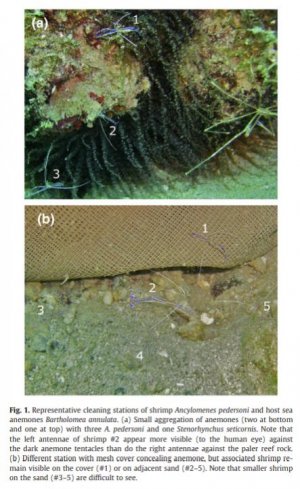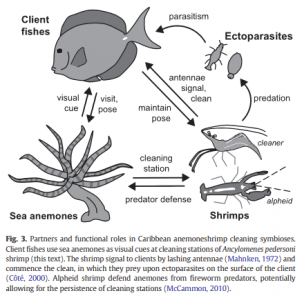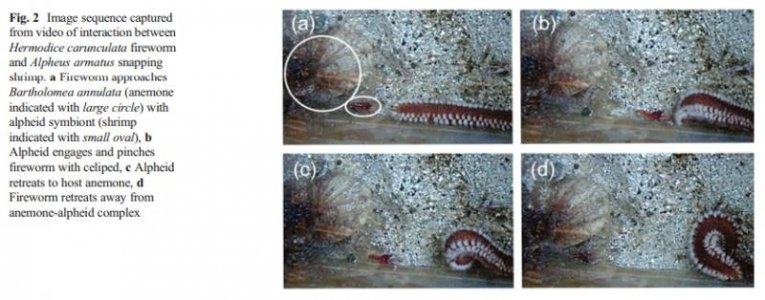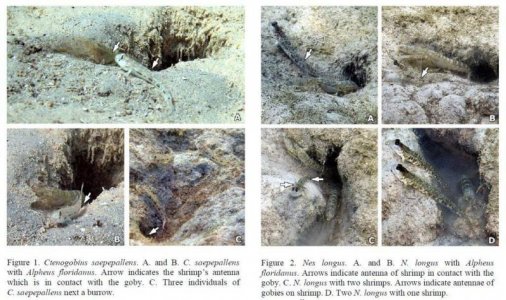ThRoewer
New member
For those interested in a Caribbean biotope tank, there are some interesting symbioses involving anemones:



Reef fishes use sea anemones as visual cues for cleaning interactions with shrimp
Abstract
"Marine cleaners benefit diverse fish clients via removal of ectoparasites, yet little is known about how fishes locate small, inconspicuous cleaner shrimps on coral reefs. Pederson shrimp Ancylomenes pedersoni are effective cleaners in the Caribbean Sea, and additionally form obligate associations with corkscrew sea anemones Bartholomea annulata, which also serve as hosts to a variety of other crustacean symbionts. We examined the visual role of B. annulata to reef fishes during cleaning interactions with A. pedersoni by comparing anemone characteristics with fish visitation rates, and by manipulating the visibility of anemones and cleaner shrimp in field experiments using mesh covers. Rates of visitation by fishes to cleaning stations increased primarily with anemone body size and the total number of crustacean symbionts, but did not change consistently in response to covers. Fishes posed for cleaning at stations only where anemones remained visible, regardless of whether shrimp were visible. Shrimp at stations where anemones were covered performed fewer cleaning interactions with fishes, as fishes did not continue to pose when anemones were not visible. We conclude that anemones serve as visual cues to client fishes prior to cleaning by shrimp. These visual cues facilitate fish cleaning interactions with shrimp, and provide a previously unknown symbiotic benefit to cleaner shrimp from association with sea anemones."
Protection of host anemones by snapping shrimps: a case for symbiotic mutualism?
Abstract
"The sea anemone Bartholomea annulata is an ecologically important member of Caribbean coral reefs which host a variety of symbiotic crustacean associates. Crustacean exosymbionts typically gain protection from predation by dwelling with anemones. Concurrently, some symbionts may provide protection to their host by defending against anemone predators such as the predatory fireworm, Hermodice carunculata, which can severely damage or completely devour prey anemones. Herein we show through both field and laboratory studies that anemones hosting the symbiotic alpheid shrimp Alpheus armatus are significantly less likely to sustain damage by H. carunculata than anemones without this shrimp. Our results suggest that the association between A. armatus and B. annulata, although complex because of the numerous symbionts involved, may be closer to mutualism on the symbiotic continuum."
And there are even Goby-Shrimp symbioses like in the Indo-Pacific:

A comparative study of two goby shrimp associations in the
Caribbean Sea
Abstract:
"In Curacao (Netherland Antilles, Caribbean Sea), two species of gobies, Nes longus (N. longus) (Nichols 1914) and Ctenogobius saepepallens (C. saepepallens) (Gilbert & Randall 1968) with their associated shrimp Alpheus floridanus (A. floridanus) (Kingsley 1878) were observed. Data were collected on feeding behaviour, distances from their burrows, and interactions among conspecifics. Results confirm that the partnership of C. saepepallens and its shrimp is facultative, but show differences to former observations. Possible reasons for this are discussed."
Reef fishes use sea anemones as visual cues for cleaning interactions with shrimp
Abstract
"Marine cleaners benefit diverse fish clients via removal of ectoparasites, yet little is known about how fishes locate small, inconspicuous cleaner shrimps on coral reefs. Pederson shrimp Ancylomenes pedersoni are effective cleaners in the Caribbean Sea, and additionally form obligate associations with corkscrew sea anemones Bartholomea annulata, which also serve as hosts to a variety of other crustacean symbionts. We examined the visual role of B. annulata to reef fishes during cleaning interactions with A. pedersoni by comparing anemone characteristics with fish visitation rates, and by manipulating the visibility of anemones and cleaner shrimp in field experiments using mesh covers. Rates of visitation by fishes to cleaning stations increased primarily with anemone body size and the total number of crustacean symbionts, but did not change consistently in response to covers. Fishes posed for cleaning at stations only where anemones remained visible, regardless of whether shrimp were visible. Shrimp at stations where anemones were covered performed fewer cleaning interactions with fishes, as fishes did not continue to pose when anemones were not visible. We conclude that anemones serve as visual cues to client fishes prior to cleaning by shrimp. These visual cues facilitate fish cleaning interactions with shrimp, and provide a previously unknown symbiotic benefit to cleaner shrimp from association with sea anemones."
Protection of host anemones by snapping shrimps: a case for symbiotic mutualism?
Abstract
"The sea anemone Bartholomea annulata is an ecologically important member of Caribbean coral reefs which host a variety of symbiotic crustacean associates. Crustacean exosymbionts typically gain protection from predation by dwelling with anemones. Concurrently, some symbionts may provide protection to their host by defending against anemone predators such as the predatory fireworm, Hermodice carunculata, which can severely damage or completely devour prey anemones. Herein we show through both field and laboratory studies that anemones hosting the symbiotic alpheid shrimp Alpheus armatus are significantly less likely to sustain damage by H. carunculata than anemones without this shrimp. Our results suggest that the association between A. armatus and B. annulata, although complex because of the numerous symbionts involved, may be closer to mutualism on the symbiotic continuum."
And there are even Goby-Shrimp symbioses like in the Indo-Pacific:
A comparative study of two goby shrimp associations in the
Caribbean Sea
Abstract:
"In Curacao (Netherland Antilles, Caribbean Sea), two species of gobies, Nes longus (N. longus) (Nichols 1914) and Ctenogobius saepepallens (C. saepepallens) (Gilbert & Randall 1968) with their associated shrimp Alpheus floridanus (A. floridanus) (Kingsley 1878) were observed. Data were collected on feeding behaviour, distances from their burrows, and interactions among conspecifics. Results confirm that the partnership of C. saepepallens and its shrimp is facultative, but show differences to former observations. Possible reasons for this are discussed."




